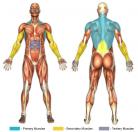Bent-Over Rows (Barbell)
- Stand with your legs about shoulder-width apart and slightly bent, grasp the barbell with an overhand grip (i.e. palms facing inward, toward your body) that is wider than shoulder-width (as this is necessary for the back to be properly targeted), and, keeping your back straight, lift the weight off the ground. This should be achieved with your legs. At this point, your torso should be at around a 45 degree angle with horizontal, your arms should be hanging straight in front of you (the bar will be in the vicinity of knee level), and your head should be up (and fixed on an object in front of you to help maintain balance) . This is the starting position.
- Keeping your lower back and abdominals isometrically contracted, pull the barbell upward toward your upper abdomen, while exhaling throughout the movement. Squeeze your shoulder blades together at the top of the pull to optimally target the trapezius and rhomboids of the upper back.
- Lower the barbell until your arms hang straight, inhaling throughout the movement.
- Repeat steps 2-3 for as many repetitions as are desired.
Which muscles are primarily targeted can be altered by changing one's grip type and position (overhand vs. underhand; wide vs. narrow) and/or the angle of one's lean.
Varying Grip: An overhand grip (i.e. hands pronated) will result in optimal lower trapezius and rhomboid contraction, while an underhand grip (i.e. hand supinated) will result in optimal upper trapezius and biceps brachii contraction.
A wider grip will result in more focus on the back muscles, while a narrower grip will result in more focus on the biceps.
A more upright lean will target the upper back muscles more, while a more bent-over lean will target the middle back muscles more.
Caution should be taken as the lower back is used to stabilize the body while performing this exercise. Under no circumstances should the back be rounded. Always keep the lower back in a neutral, straight position.





